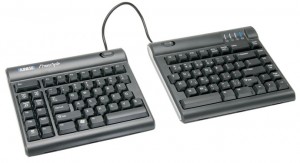How to Choose the Best Keyboard Design for You
12/11/2012

by Kerri Maurina, AEP
The majority of office jobs require the use of external devices such as a keyboard and mouse. In recent years, keyboards have shifted from the standard dimensions (17"W x 6"D x 1"H) to variable designs geared towards improving posture. Keyboards come in various shapes and sizes now with changes in elevation, angle, and separation. With multiple keyboard options available how do you know what design is best for you?
The Angled Keyboard:
The angled keyboard offers a 0 to 30 degree horizontal adjustment via a pivot mechanism at the top portion of the keyboard. This adjustability allows users to select various angles to suit their ideal wrist posture. For users with broad shoulders, increasing (widening) the angle of the keyboard can reduce internal rotation at the shoulders and ulnar deviation at the wrist creating a more neutral posture.
The Separated Keyboard:
The separated keyboard offers a physical separation up to 8 inches where the medial portion of the keyboard detaches. For usersthat do not find the angled keyboard comfortable, physically separating the keyboard outwards can reduce internal rotation at the shoulders and elbows, while the wrist remains straight. Since the keyboard separates, adjustments to the angle can also be made.
So, when should you use an angled or separated keyboard?
Angled and separated keyboards are recommended for users with broad shoulders. The 95th percentile female and male shoulder breadth is approximately 17" and 20", respectively (ANSI/HFS 100-2007 American National Standard for Human Factors Engineering of Visual Display Terminal Workstations). When typing, most users move their hands within a 6" radius from the space bar exposing the shoulders to internal rotation and the wrist to radial/ulnar deviation.
Both keyboard styles are advantageous for users with broad shoulders and who assume awkward wrist postures when typing. The angled keyboard allows adjustments to be made at the hands and wrists to position in a neutral posture thereby reducing discomfort. The separating keyboard allows adjustments to be made at the elbows to decrease internal rotation since they are aligned with the shoulders.






